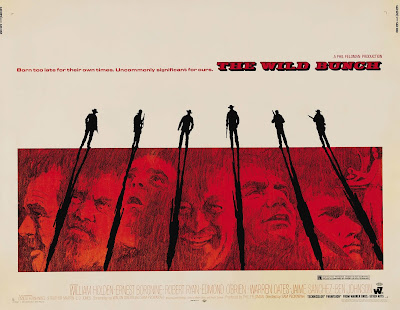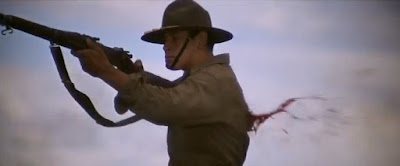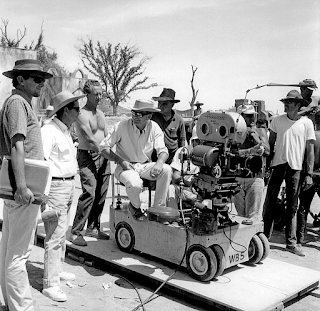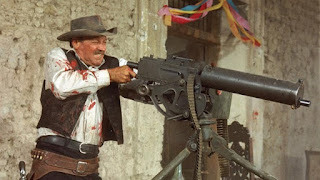The Wild Violence of 'The Wild Bunch'
 Sam
Peckinpah’s The Wild Bunch tears at
the screen with blood and violence. The violence in The Wild Bunch is not only historical but also revolutionary. While
the film is one of the most controversial movies of its time, today, its
controversy remains a frequently revisited and debated subject among scholars,
critics, and movie patrons (Gronstad 167). When The Wild Bunch was first release in 1969, critics and general
audiences were incredibly divided (Ferrera). Many critics embraced Peckinpah’s
vision and use of violence and blood. Others admonished Peckinpah for his
brutality and vivid portrays of on-screen violence. Some may feel as though the
violence of The Wild Bunch is
antiquated when compared to the portrayals of on-screen violence seen today.
However, according to Ferrera, the way Peckinpah uses violence changed how filmmakers
portray violence, in particular gun violence, on screen. Unlike previous
western films, Peckinpah showed audiences that death and violence are bloody
and miserable. Even today, the graphic violence in The Wild Bunch is a
subject of controversy and debate. Despite the controversy of the past and
present that obsesses on Peckinpah’s use of violence, blood and guns, The Wild Bunch remains of the most
celebrated and influential American Westerns of all time.
Sam
Peckinpah’s The Wild Bunch tears at
the screen with blood and violence. The violence in The Wild Bunch is not only historical but also revolutionary. While
the film is one of the most controversial movies of its time, today, its
controversy remains a frequently revisited and debated subject among scholars,
critics, and movie patrons (Gronstad 167). When The Wild Bunch was first release in 1969, critics and general
audiences were incredibly divided (Ferrera). Many critics embraced Peckinpah’s
vision and use of violence and blood. Others admonished Peckinpah for his
brutality and vivid portrays of on-screen violence. Some may feel as though the
violence of The Wild Bunch is
antiquated when compared to the portrayals of on-screen violence seen today.
However, according to Ferrera, the way Peckinpah uses violence changed how filmmakers
portray violence, in particular gun violence, on screen. Unlike previous
western films, Peckinpah showed audiences that death and violence are bloody
and miserable. Even today, the graphic violence in The Wild Bunch is a
subject of controversy and debate. Despite the controversy of the past and
present that obsesses on Peckinpah’s use of violence, blood and guns, The Wild Bunch remains of the most
celebrated and influential American Westerns of all time.
Perhaps
the most intriguing aspect of The Wild
Bunch’s reception is the debate among popular critics around the time of
the film’s release. Film audiences had not seen explicit portrayals of violence
before Peckinpah’s masterpiece (Ferrera). Bullet holes rip through clothing and
human bodies, and blood gushes as the bullets rip through a character’s body.
Peckinpah showed the killing of innocent bystanders. The perpetrators of
violence use other humans as shields from cascades of bullets. Children giggle
as hordes of ants devour a scorpion alive, and later, the children set fire to both
the scorpions and ants. The aftermath of gun battle in The Wild Bunch is gruesome and scary. The brightest color in the
film is blood. For its time, the violence of The Wild Bunch was unmatched, and many critics and audience members
were unsettled and outraged (Canby). Vincent Canby of The New York Times suggests that other critics of the time seemed
to have felt as though the film would cause viewers to want to leave the theater
and automatically start murdering people. Canby affirms that an impulse to
inflict violence on people was not present after watching The Wild Bunch, and the film, “Is very beautiful and the first
truly interesting, American-made Western in years.”
Although
many critics felt as though the film was too violent and not suitable for
humanity, Charles Champlin and Roger Ebert celebrated the film. Champlin often
squinted during the film in a futile attempt to escape the violence. He refers
to The Wild Bunch as, “Not so much a
movie as a blood bath,” but affirms that the film is, “Brilliantly made and
thought provoking.” Champlin notes the original test audiences of The Wild Bunch recoiled in horror and
stormed out of the theaters in droves. Apparently, members of test screenings
picketed the theaters the next day, and Warner Brothers made Peckinpah cut 35
minutes of violence before officially releasing the film (Champlin). However,
Champlin defended the film’s portrayal of violence, and notes that death in The Wild Bunch is depraved and gut
wrenching, just as it is in real life. Roger Ebert also celebrated and defended
the film’s use of violence with veracity and eloquence. Ebert affirms that the
larger cultural issue at hand is that we depict cowboys, Indians, and the Old
West as a fun game for children to play.
 While Peckinpah did not make a cowboys
and Indians film, The Wild Bunch attacks
and destroys the notion of the traditional Western. Ebert notes that Peckinpah
utilized excessive violence, but this violence merely comes as a reaction and a
response to violence enacted throughout the world on a daily basis. This
response to violence continues to reverberate through modern-day culture and
violence. After seeing The Wild Bunch a
second time, Ebert described some of
Peckinpah’s use of violence as, “Blood flowing in an unending stream” and
“Geysers of blood everywhere.” While Peckinpah’s use of violence is graphic and
unlike any other film of its time, interestingly, Ebert’s statements were
hyperbole. Nonetheless, Ebert argues that regardless of how graphic and
realistic Peckinpah’s on-screen violence may have been, the film exists in a
one-dimensional realm, realism is not synonymous with reality, and it is
“Impossible to forget this is a movie.”
While Peckinpah did not make a cowboys
and Indians film, The Wild Bunch attacks
and destroys the notion of the traditional Western. Ebert notes that Peckinpah
utilized excessive violence, but this violence merely comes as a reaction and a
response to violence enacted throughout the world on a daily basis. This
response to violence continues to reverberate through modern-day culture and
violence. After seeing The Wild Bunch a
second time, Ebert described some of
Peckinpah’s use of violence as, “Blood flowing in an unending stream” and
“Geysers of blood everywhere.” While Peckinpah’s use of violence is graphic and
unlike any other film of its time, interestingly, Ebert’s statements were
hyperbole. Nonetheless, Ebert argues that regardless of how graphic and
realistic Peckinpah’s on-screen violence may have been, the film exists in a
one-dimensional realm, realism is not synonymous with reality, and it is
“Impossible to forget this is a movie.”
 While Peckinpah did not make a cowboys
and Indians film, The Wild Bunch attacks
and destroys the notion of the traditional Western. Ebert notes that Peckinpah
utilized excessive violence, but this violence merely comes as a reaction and a
response to violence enacted throughout the world on a daily basis. This
response to violence continues to reverberate through modern-day culture and
violence. After seeing The Wild Bunch a
second time, Ebert described some of
Peckinpah’s use of violence as, “Blood flowing in an unending stream” and
“Geysers of blood everywhere.” While Peckinpah’s use of violence is graphic and
unlike any other film of its time, interestingly, Ebert’s statements were
hyperbole. Nonetheless, Ebert argues that regardless of how graphic and
realistic Peckinpah’s on-screen violence may have been, the film exists in a
one-dimensional realm, realism is not synonymous with reality, and it is
“Impossible to forget this is a movie.”
While Peckinpah did not make a cowboys
and Indians film, The Wild Bunch attacks
and destroys the notion of the traditional Western. Ebert notes that Peckinpah
utilized excessive violence, but this violence merely comes as a reaction and a
response to violence enacted throughout the world on a daily basis. This
response to violence continues to reverberate through modern-day culture and
violence. After seeing The Wild Bunch a
second time, Ebert described some of
Peckinpah’s use of violence as, “Blood flowing in an unending stream” and
“Geysers of blood everywhere.” While Peckinpah’s use of violence is graphic and
unlike any other film of its time, interestingly, Ebert’s statements were
hyperbole. Nonetheless, Ebert argues that regardless of how graphic and
realistic Peckinpah’s on-screen violence may have been, the film exists in a
one-dimensional realm, realism is not synonymous with reality, and it is
“Impossible to forget this is a movie.”
In
addition to the variety of responses and debate among film critics and audience
members at the time of The Wild Bunch’s release,
controversy and commentary continues in modern times. Books, scholarly
articles, and blogs continue to chronical and add to the discussion of
Peckinpah’s portrayal of on-screen violence in The Wild Bunch. In Cowboy Metaphysics, Peter A. French does
not share the same spirit of support for Peckinpah’s portrayals of violence as Roger
Ebert. French categorizes Peckinpah’s use of violence as simply an, “Extreme
consciousness of death” (84). According to French, the main characters are
courageous and heroic, but they are slightly demonic and lack true altruism in
their supposedly heroic actions (126). The concept of a person committing to
their word as the single attribute necessary to achieve the highest level of
moral integrity in The Wild Bunch is
particularly unsettling to French. French argues that this brand of integrity
utilized in The Wild Bunch causes one
to overlook the appalling traits and violence behavior of the film’s characters
(128). In other words, if a character is seen as possessing integrity, their
awful behavior is justified, and to a certain degree integrity becomes a device
that glorifies violent acts regardless of whether the violence is justifiable
or not.
 Meanwhile,
critical researcher Asbjorn Gronstad highlights and supports many critically
justifiable functions of Peckinpah’s use of violence. Gronstad compares
Peckinpah’s The Wild Bunch to Thoreau’s Walden, not in plot but in
meaning and allegory (169). According to Gronstad, morality is not the
overarching theme of the film and its violence. Instead, the film is an
allegory for the battle between nature and technological progress (Gronstad 170).
Observing and drawing conclusions solely from the lens of morality not only
negates Peckinpah’s sense of morality, but also ignores a deeper and important
thematic dynamic at play in The Wild Bunch. Gronstad frames Peckinpah’s
portrayals of violence as both an admonishment of violence and violence toward,
“Socio-cultural homogenization” (169). Additionally, Gronstad claims that by
re-representing the past, specifically the Old West, in a more appropriate and
accurate light, viewers are able to draw a correlation to the present and
possible futures of humanity (171). In order to understand the present, and
violence situated in the present, we must work to stop glorifying the past.
Violence is not a virtue to Peckinpah. Instead, Peckinpah depicts violence as a
product of a bleak world in which humanity is always at odds with machine, and
in this world, there is no hope for the past, present, or future (Gronstad
184).
Meanwhile,
critical researcher Asbjorn Gronstad highlights and supports many critically
justifiable functions of Peckinpah’s use of violence. Gronstad compares
Peckinpah’s The Wild Bunch to Thoreau’s Walden, not in plot but in
meaning and allegory (169). According to Gronstad, morality is not the
overarching theme of the film and its violence. Instead, the film is an
allegory for the battle between nature and technological progress (Gronstad 170).
Observing and drawing conclusions solely from the lens of morality not only
negates Peckinpah’s sense of morality, but also ignores a deeper and important
thematic dynamic at play in The Wild Bunch. Gronstad frames Peckinpah’s
portrayals of violence as both an admonishment of violence and violence toward,
“Socio-cultural homogenization” (169). Additionally, Gronstad claims that by
re-representing the past, specifically the Old West, in a more appropriate and
accurate light, viewers are able to draw a correlation to the present and
possible futures of humanity (171). In order to understand the present, and
violence situated in the present, we must work to stop glorifying the past.
Violence is not a virtue to Peckinpah. Instead, Peckinpah depicts violence as a
product of a bleak world in which humanity is always at odds with machine, and
in this world, there is no hope for the past, present, or future (Gronstad
184).  While
controversy and debate about Peckinpah’s use of violence continues over 40
years after the film’s release, The Wild Bunch remains a, “Seminal work
of violence and artistry that forever changed the landscape of motion pictures”
(Ferrara). According to Ferrara, Peckinpah was the first to use violence as a
slowed-down, graphically choreographed visual motif. The sound of flies buzzing
over dead bodies, squibs aggressively flinging blood across the screen,
different angles of the same action, and the double and triple printing of film
were all innovative techniques Peckinpah utilized to depict on-screen violence
(Ferrara). While these techniques are a victory of filmmaking that many
filmmakers utilize today, they are also the source of much of The Wild
Bunch’s controversy. Prior to The Wild Bunch’s release, the
Production Code had not yet been eradicated (Ferrara). According to Ferrara,
the Production Code was eventually eradicated and replaced by the MPAA, yet the
MPAA strongly objected to the violence and required Peckinpah to remove a scene
that graphically displays the cutting of a character’s throat. Upon test screening the film, after making the
necessary cuts, audience members’ reactions were often extremely negative, and
Ferrara quotes one early audience member saying, “Don’t release this film. The
whole thing is sick.” Despite the controversy and the MPAA’s objections to the
depictions of violence in The Wild Bunch, the film received several
prestigious awards. In 1999, The Wild Bunch was added to the National
Film Registry (Ferrara).
While
controversy and debate about Peckinpah’s use of violence continues over 40
years after the film’s release, The Wild Bunch remains a, “Seminal work
of violence and artistry that forever changed the landscape of motion pictures”
(Ferrara). According to Ferrara, Peckinpah was the first to use violence as a
slowed-down, graphically choreographed visual motif. The sound of flies buzzing
over dead bodies, squibs aggressively flinging blood across the screen,
different angles of the same action, and the double and triple printing of film
were all innovative techniques Peckinpah utilized to depict on-screen violence
(Ferrara). While these techniques are a victory of filmmaking that many
filmmakers utilize today, they are also the source of much of The Wild
Bunch’s controversy. Prior to The Wild Bunch’s release, the
Production Code had not yet been eradicated (Ferrara). According to Ferrara,
the Production Code was eventually eradicated and replaced by the MPAA, yet the
MPAA strongly objected to the violence and required Peckinpah to remove a scene
that graphically displays the cutting of a character’s throat. Upon test screening the film, after making the
necessary cuts, audience members’ reactions were often extremely negative, and
Ferrara quotes one early audience member saying, “Don’t release this film. The
whole thing is sick.” Despite the controversy and the MPAA’s objections to the
depictions of violence in The Wild Bunch, the film received several
prestigious awards. In 1999, The Wild Bunch was added to the National
Film Registry (Ferrara).  Peckinpah’s
own reaction to The Wild Bunch’s release is perhaps one of the most
compelling commentaries on the film’s use of violence. Even though there were
several audience members that recoiled in horror and condemned the violence in
the film, Peckinpah was more appalled by stories of audience members that
cheered and attained enjoyment from the film’s violence (Ferrara). Nonetheless,
Peckinpah ultimately defended his depictions of violence when condemned by
critics, and Peckinpah condemned the idea that he was using on-screen violence
as something that is fun and enjoyable (Ferrara). While Peckinpah romanticized
the beautiful Mexican landscape in which the film is set, the depictions of
violence are brutal, dirty, and devastating. Peckinpah was nicknamed “Bloody
Sam” and the final shoot out of The Wild Bunch the “Blood ballet,” yet Peckinpah
used violence in the film to speak out against the Vietnam War and violence in
general (Ferrara). As Peckinpah himself said, “I wasn't trying to make an epic.
I was trying to tell a simple story about bad men in changing times. I was
trying to make a few comments on violence, and the people who live by violence.”
Peckinpah’s
own reaction to The Wild Bunch’s release is perhaps one of the most
compelling commentaries on the film’s use of violence. Even though there were
several audience members that recoiled in horror and condemned the violence in
the film, Peckinpah was more appalled by stories of audience members that
cheered and attained enjoyment from the film’s violence (Ferrara). Nonetheless,
Peckinpah ultimately defended his depictions of violence when condemned by
critics, and Peckinpah condemned the idea that he was using on-screen violence
as something that is fun and enjoyable (Ferrara). While Peckinpah romanticized
the beautiful Mexican landscape in which the film is set, the depictions of
violence are brutal, dirty, and devastating. Peckinpah was nicknamed “Bloody
Sam” and the final shoot out of The Wild Bunch the “Blood ballet,” yet Peckinpah
used violence in the film to speak out against the Vietnam War and violence in
general (Ferrara). As Peckinpah himself said, “I wasn't trying to make an epic.
I was trying to tell a simple story about bad men in changing times. I was
trying to make a few comments on violence, and the people who live by violence.”
 Although
Peckinpah expressed disappointed that audience members were thrilled and
enjoyed the violence, even Roger Ebert admits enjoying Peckinpah’s use of
violence. While audiences were divided on whether certain elements of The
Wild Bunch are enjoyable or detestable, the film depicts violence, death,
and the gun as gruesome and unenjoyable elements of the world. This depiction
was Peckinpah’s goal, and the film does not glorify violence but rather
condemns violence in the world. If nothing else, Peckinpah managed to produce a
violent film that is still a subject of controversy today. Many critiques of The
Wild Bunch, such as French’s Cowboy Metaphysics, paint a grim
picture of how Peckinpah depicted violence in The Wild Bunch. However,
many popular critics and scholars defend Peckinpah’s use and aesthetic of
violence. Ultimately, it seems as though the individuals commenting on the
violence in The Wild Bunch are more obsessed with violence than the film
itself or Peckinpah, because despite the insurmountable amount of commentary on
the violence in The Wild Bunch, I could not find a source that mentions the
film ending in laughter and song.
Although
Peckinpah expressed disappointed that audience members were thrilled and
enjoyed the violence, even Roger Ebert admits enjoying Peckinpah’s use of
violence. While audiences were divided on whether certain elements of The
Wild Bunch are enjoyable or detestable, the film depicts violence, death,
and the gun as gruesome and unenjoyable elements of the world. This depiction
was Peckinpah’s goal, and the film does not glorify violence but rather
condemns violence in the world. If nothing else, Peckinpah managed to produce a
violent film that is still a subject of controversy today. Many critiques of The
Wild Bunch, such as French’s Cowboy Metaphysics, paint a grim
picture of how Peckinpah depicted violence in The Wild Bunch. However,
many popular critics and scholars defend Peckinpah’s use and aesthetic of
violence. Ultimately, it seems as though the individuals commenting on the
violence in The Wild Bunch are more obsessed with violence than the film
itself or Peckinpah, because despite the insurmountable amount of commentary on
the violence in The Wild Bunch, I could not find a source that mentions the
film ending in laughter and song.
Works
Cited
Canby, Vincent. “Violence and
Beauty Mesh in Wild Bunch” 26 June
1969. New York Times... Web. Mar.
2015.
Champlin, Charles. “Violence Runs
Rampant in The Wild Bunch.” Los Angeles Times 15 June,
1969... Web. 1 Mar. 2015.
Ebert, Roger. “The Wild Bunch.” Chicago Sun-Times 3 Aug. 1969. Rogerebert.com, n.d.
Web. 1 Mar 2015.
Ferrara, Greg. The Wild Bunch: Articles. Turner
Classic Movies, Turner Sports and
Entertainment
Digital Network, n.d. Web. 1 Mar 2015.
French, Peter A. Cowboy Metaphysics. Lanham, MD: Rowman
& Littlefield, 1997. Print.
Gronstad, Asbjorn. “Peckinpah’s Walden: The Violent Indictment of
‘Civilization’ in The Wild
Bunch.” Critical Studies 15.1 (2001): 167-186. ASU Library One Search. Web. 1 Mar. 2015.
Peckinpah, Sam, dir. The Wild Bunch. Perf. William Holden,
Ernest Borgnine, and Robert Ryan.
Warner
Brothers/Seven Arts, 1969. Film.


